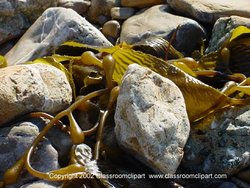Seaweed
|
|

Seaweeds are found among the green, red, and brown algae. Some cyanobacteria may also be counted as seaweeds. Seaweeds are named after terrestrial "weeds", and are not to be confused with things like seagrass which are vascular plants and not algae.
Structure
Kelp_forest_Otago_1s.JPG
Seaweeds may have an appearance that resembles non-arboreal terrestrial plants.
- thallus: the algal body
The stipe and front are collectively known as frond.
Uses
Seaweeds are used extensively as food by coastal peoples, most particularly in Japan but also in Korea, China, Indonesia, Peru, the Canadian Maritimes, Scandinavia, Ireland, Wales, Philippines, and Scotland, among other places. For example, laver is a red alga used in Wales to make laverbread, and in Japan dried, formed into sheets called nori, and used to wrap sushi. Irish moss is another red alga used in producing various food additives.
Seaweed is also used for the production of Alginate, a versatile product that is used for a whole range of applications. These include the production of Agar which is used very widely in microbiology as a substrate for culturing organisms. Alginates are also used in the production of foodstuffs to improve texture and mouth-feel. Typical products are ice-cream and a range of proprietary desserts (see Carrageenan).
Other seaweeds may be used as seaweed fertiliser.
Fucus_vesiculosus.JPG
